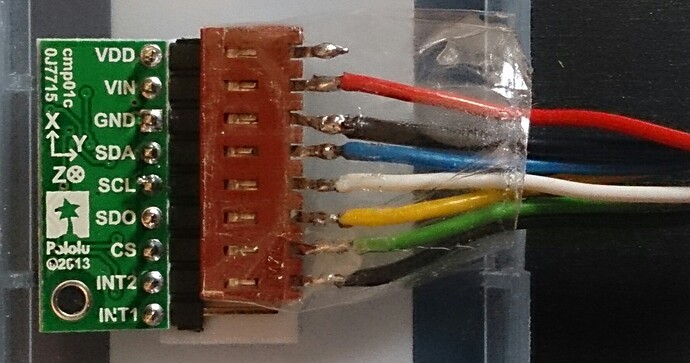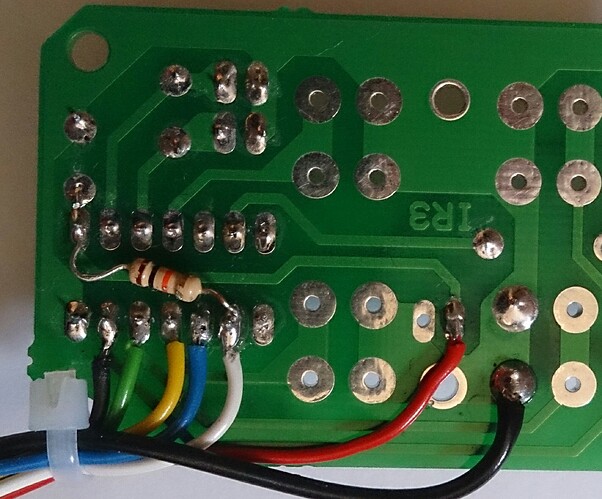A typical (bad!) output (with the z acceleration axis vertical) is this, where the six readings are Ax,Ay,Az,Mx,My,Mz.
+0032,+0000,+0000,-3193,+0054,+5070
+0032,+0000,+0000,-3196,+0051,+5080
+0032,-0032,+0000,-3196,+0047,+5055
+0000,+0000,+0032,-3163,+0006,+5059
+0000,+0000,+0000,-3209,+0019,+5090
-0032,+0000,+0032,-3144,+0059,+5077
-0032,+0000,-0032,-3179,+0022,+5051
+0000,+0000,-0032,-3172,+0043,+5075
-0032,+0000,+0000,-3170,-0037,+5050
+0032,+0000,+0032,-3209,+0051,+5081
+0032,+0000,+0000,-3191,-0037,+5049
You can see that the magnetometer values look good, whereas all the accelerometer values are wrong - there is no z-axis value, for example.
The I2C is running at 100kHz, and I can send you the I2C driver code if it helps, but I know the I2C is working because I can read back the CTRL registers after loading them.
These are the constants I use in the code:
#define SAD_WRITE 0b00111010 //The slave address ID for high SD0/SDA
#define SAD_READ 0b00111011 //for reading (after a repeated start)
#define CTRL0_ADD 0x9F //the address of CTRL0 (0x1F) with bit 7 set for auto-increment
#define CTRL0 0b00000000 //for normal mode, filters by-passed
#define CTRL1 0b01001111 //update after read, and all axes of acceleration enabled at 25Hz
#define CTRL2 0b11000001 //50Hz anti-alias, +/- 2g, no self-test, (SPI 3-wire)
#define CTRL3 0b00000000 //No INT1 actions
#define CTRL4 0b00001000 //accelerometer data ready on INT2.
#define CTRL5 0b00001110 //No temperature, low-res magnetic, 25Hz, latch interrupt on INT2
#define CTRL6 0b00000000 //+/-2gauss sensitivity.
#define CTRL7 0b00100000 //normal high-pass acceleration filter, no Temp, magnetic always on, continuous conversion mode
//#define STATUS_REG_A 0b00000000 //ditto?
//the first address for six bytes of magnetic data:
#define OUT_X_L_M 0x88 //the address of the low byte of the x magnetic, bit 7 set = autoincrement.
//then 9, A, B, C, D, are the high/low/high/low/high addresses of X, Y, Z magnetic sensors
#define STATUS_M 0x07
#define MASK_ZYXADA 0b00000111
//the first address for six bytes of acceleration data:
#define OUT_X_L_A 0xA8 //bit 7 is set = auto-increment
#define STATUS_A 0x27
#define MASK_ZYXMDA 0b00000111
//__________________________________________________________________
This is the code which reads the accelerometers (written in Hitech C for Microchip 16F1824):
unsigned char read_status_A(void) {
unsigned char temp;
send_start();
write_byte(SAD_WRITE); //to write to the accelerometer registers.
write_byte(STATUS_A); //no repeat
send_start(); //repeated start for reading
write_byte(SAD_READ); //switch device to read from the magnetometer registers.
temp = read_byte_no_ACK(); //all the bits, no ACK
send_stop();
temp &= MASK_ZYXADA;
return temp;
}
//__________________________________________________________________
void read_accelerometers(void) { //sends the three magnetic configuration bytes
PORTC = 0;//Make sure all the port latches are low before we get going:
while(INT2 == 0) { //check data valid
// while(read_status_A() == 0) { //check data valid
if(TEST_OUT == 0)
TEST_OUT = 1;
else
TEST_OUT = 0;
CLRWDT();
}
TEST_OUT = 0;
send_start();
write_byte(SAD_WRITE); //to write to the accelerometer registers.
write_byte(OUT_X_L_A); //write first byte address to read from (with bit 7 set set to auto-increment).
send_start(); //repeated start for reading
write_byte(SAD_READ); //switch device to read from the accelerometer registers.
ax[0] = read_byte(); //LSByte
ax[1] = read_byte(); //MSByte
ay[0] = read_byte();
ay[1] = read_byte();
az[0] = read_byte();
az[1] = read_byte_no_ACK();
send_stop();
x_acc = ax[1];
x_acc <<= 8;
x_acc |= ax[0];
// x_acc >>= 4; //acceleration values are sent left-shifted!
x_acc_value = (double)x_acc;
y_acc = ay[1];
y_acc <<= 8;
y_acc |= ay[0];
// y_acc >>= 4; //acceleration values are sent left-shifted!
y_acc_value = (double)y_acc;
z_acc = az[1];
z_acc <<= 8;
z_acc |= az[0];
// z_acc >>= 4; //acceleration values are sent left-shifted!
z_acc_value = (double)z_acc;
}
//__________________________________________________________________



